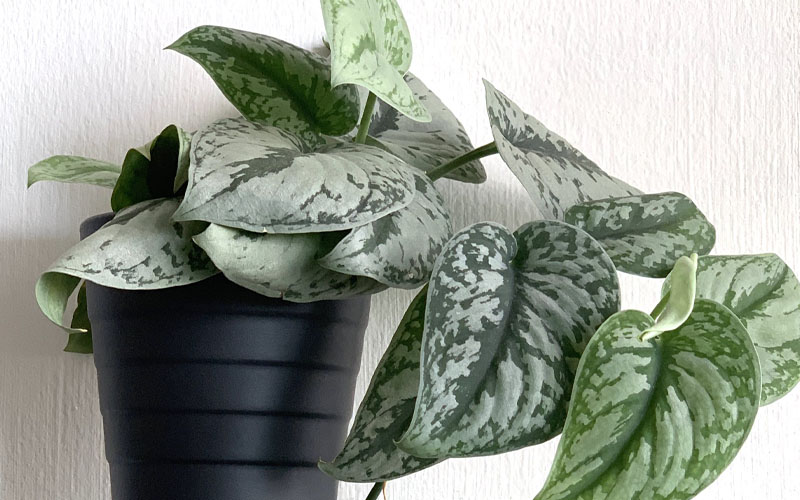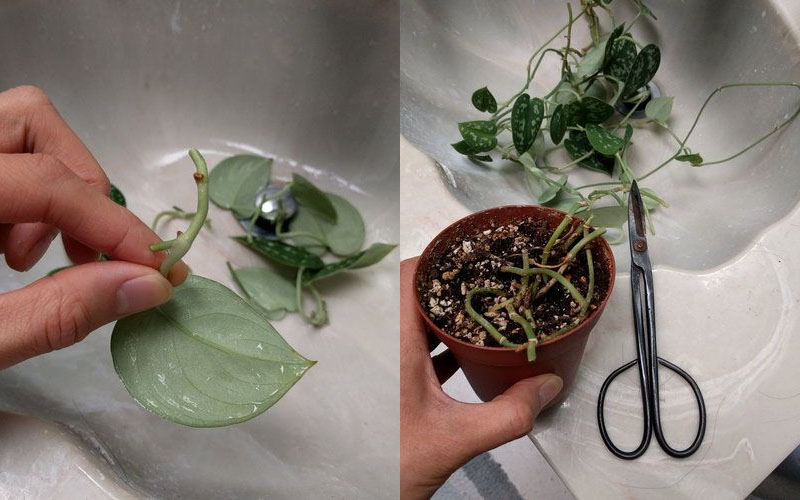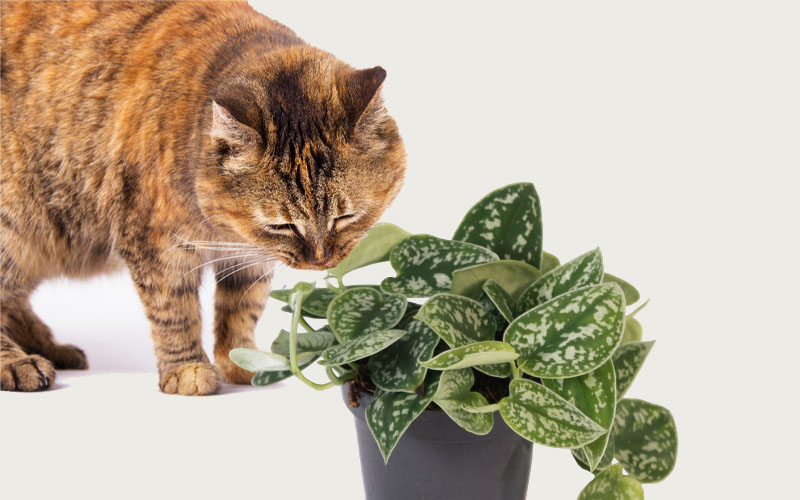Vining plants are always our preferred choice
Why?
Just like Peperomia, they are easy to grow and maintain.
And extend to a larger area than normal plants.
Scindapsus Pictus is one of such climbing plants – just like Money Plant,
with much more attractive foliage and silvery variegation.
So, let’s get to know about growing this amazing plant at home.
Table of Contents
What is scindapsus pictus?

Scindapsus Pictus, Silver Vine, Satin Pothos or Silver Pothos is an evergreen vining plant with heart-shaped velvety leaves marked with silver variegation. It’s native to Bangladesh, Thailand, Malaysia, Philippines.
Even though it’s called Satin photos, but by botanical definition, it’s not pothos. It usually comes in two types, Exotica and Argyraeus.
Satin pothos varieties
There are two main varieties of Scindpaus pictus that exist. One is Exotica, and the other is called Argyraeeus. Both of them have other names as well, as discussed below.
Let’s get to know their difference.
Scindapsus Pictus Exotica vs. Scindapsus Pictus Argyraeus

Argyraeus has relatively shorter variegated leaves with dark green color more noticeable than the silver marks.
On the other hand, Exotica variegation has prominent silver markings combined with a light green color.
Scindapsus pictus is neither Philodendron nor Pothos
Characteristics of Satin pothos
- Easily available, easy to grow, but slow-growing.
- It’s a hanging basket plant, or you may trellis it even
- The leaves are tough to rubbery ones, which is a natural shield against intense light
- It grows in moderate to high humid areas and is intolerant of frost.
- It is native to South East Asia, like Bangladesh.
- It climbs to trees even through its aerial rootlets.
- In the US it’s grown indoor in terrariums because of its beautiful leaves
- Its flowers grow less often. They only grow in summer, when small flower spathes form, followed by small berries.
Some people confuse it with Epipremnum aureum or simply called Devil’s ivy or Money plant. The obvious difference is the silvery variegation on the leaves, which Devil’s ivy does not have.
Satin Pothos Care: How to Grow Silver Pothos?
It likes bright indirect light, perlite and soil mix, watering once a week, 18-29°C temperature, and nitrogenous fertilizer.
Before getting into the details of the required conditions for this plant, it’s essential to mention that using the latest tools saves time and the work done is accurate.
1. Soil Type
Soil mix and perlite mixture works best for this plant.
The reason for perlite is to make the mixture airier and well-drained.
Because it does not grow well in soggy and poorly-drained soil, otherwise roots will rot.
If you’re in the habit of watering your plants more often, then perlite and soil in the ratio of 50-50 is fine.
On the other hand, if you’re an under waterer, 60% soil and 40% perlite is fine.
While making the soil mix, it’s better not to do it with bare hands, as your skin may be allergic to soil, or it may contain thorns.
Claw gardening gloves can protect you from such harms
2. Water Need
How often to water this plant?
You need to water it a little bit more,
But more depends upon the light condition it’s put in.
When it’s under full sun condition, two to three times a week is just fine.
Whereas,
If you’re keeping it indoors, where there’s ambient light, watering once a week is just fine.
Another important thing to note regarding watering is,
When the leaves of this plant get curved or completely wrapped sometimes, it means the plant is thirsty.
It’s a kind of good thing that such plants communicate about their needs.
If you think you cannot take due care in watering this plant, use a self-watering 3 or 5-gallon bucket.
But still, even if you water them after their leaves get curved, it does not harm the plant.
Although watering at times results in a healthier look and fast growth rate.
It’s to be noted that yellow leaves of this plant are a sign of over-watering or poor drainage.
3. Temperature Required
Being a tropical plant, it grows well in warm temperature zones.
Since it’s more used in the US as indoor plants, the average temperature ranges from 18° to 29°C.
Do not place where the temperature is 15°C or lower, or the leaves will start to die.
4. Humidity Required
In the wild, it’s in the high humid environment in tropical and subtropical forests.
But the good things is,
You need not have high humidity in your house.
Low to moderate humidity is just fine for this plant.
5. Light Need

Another good thing is that it can live off with low light even without compromising the growth rate.
Keeping them indoor for long is not good for their growth.
A sign of low light is the production of small leaves, which otherwise would be much bigger if the plant had got more light.
6. Fertilizer Required Or Not
As far as the fertilizer goes, a fertilizer with a high amount of nitrogen is just fine for these plants.
Nitrogen is good because it will keep the foliage nice and green, which is its demanding factor.
If you want to use any synthetic fertilizer, you may use 20-10-10 fertilizer with half of the recommended amount.
Fertilizing once a month is fine in Spring and summer.
7. USDA Zone
The US hardiness zone for this plant is 11.
8. Pruning

Don’t let this plant grow too big. Instead, cut it down at the start of every Spring to a normal height.
Like pothos, it does not mind getting pruned.
So, if it’s in a hanging basket, it’s better to prune it timely, like in Spring or summer, to maintain its beautiful look.
A professional tree grafter kit may be of great help here, because of its accurate and easy-to-cut ability.
9. Things Not to Do with Satin Pothos
- Don’t plant it in the cold, as it can’t tolerate cold drafts.
- Don’t let the soil become soggy. You can prevent this by adding perlite mixture to it.
- Don’t put it under direct sunlight. Instead keep it in bright, indirect light for better growth.
- Don’t use bigger pots at the start, as they retain more water than needed. When the plant grows big then only transfer it to a bigger one.
- Don’t use a pot without a drainage hole. Even if case you use a cachepot, put a nursery pot inside it placed above a single layer of pebbles.
How to Propagate Satin Pothos?
Its propagation of Scindapsus pictus is as simple as any other vining plant. A small cutting of it with nodes present can regrow easily when put into water or soil.
1. Water propagation
For water propagation, cut any stem 4-5 inches from the tip-end just below the last leaf, ensuring it has 1-2 nodes.
Cutting at 45 degrees is better.
Once you separate the stem, remove the last leaf.
Always cut two cuttings at least and then put each in a water bottle.
It takes about 3-4 weeks for the cutting to propagate.
2. Soil Propagation

So, what’s the key to propagate Scindapsus in the soil?
It involves tip-cutting for three stems, at least, with 3-4 inches long each. Means cut below a node and remove the bottom leaves of it.
A mixture of well-moistened peat moss and coarse perlite potting mixture is the best thing to use.
Plant these three cuttings in the above mixture and around the rim of a 3-inch pot, so that they can easily be transported and grown separately later.
Enclose the whole pot in a plastic bag and place it in the filtered light area.
After 4-6 weeks, when rooting occurs, remove the plastic covering and water moderately.
Now, you might be thinking, what the right time to move each plant is?
The right time is three months from the time of propagation.
Move each plant to a versatile pot or hanging basket full of potting mix.
Common Diseases or Pests
Scindapsus is normally resilient, but sometimes diseases or bugs my catch this beautiful plant too
- Root-rots: Root rots normally happen because of overwatering.
- Brown leaf tips mean too much dry air, like directly getting a throw from an outdoor unit of an AC, whereas yellow leaves are a sign of overwatering.
Talking about pests, there are normally two types that may affect it.
Scales are sap-sucking insects that stick itself on to a stem of Scidipss pictus
- Other ones are spider mites. They are so small that they usually get undetected. They form webbings between leaves and stem and cause the leaves to have brown spots on them.
Sometimes they get noticed as a small cluster of dots or dirt on the underside of the leaf.
Are Satin Pothos toxic to cats and dogs?

There are many toxic plants in our garden, which have poisonous flowers, seeds, leaves, and sometimes the entire plant itself.
As far as Scindapsus’ toxicity is concerned, the answer is yes, unfortunately. The crystals of calcium oxalate leaves have the tendency to even burn your pet’s mouth.
It’s better to keep this plant away from your pets.
Cats have more prone to its danger, for they are more attracted to it.
So, place it far away from your cat’s reach, if possible.
Conclusion
this plant can be a great addition to your home for its beautiful silvery variegation on the leaves. Although it grows slowly, yet propagation and caring are much easier than any other plant.
Even though it’s not a pothos botanically, still you will hear people calling it so, maybe because of its growth and look of a pothos.
Try planting this at your home and share with us your experience in the comments section below.

